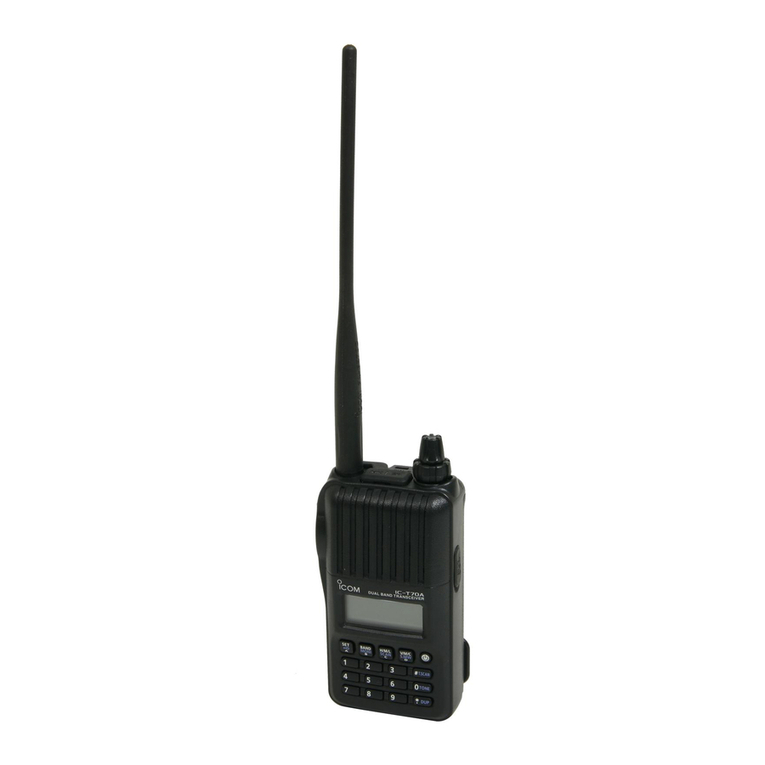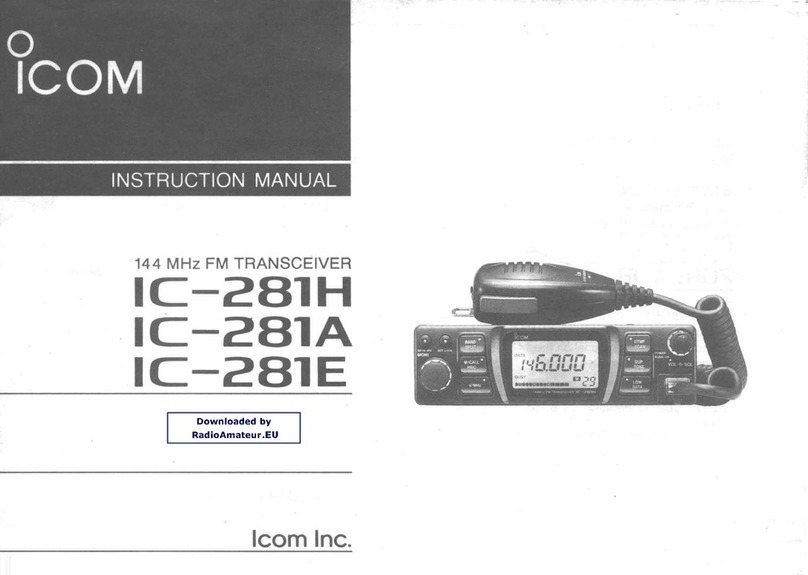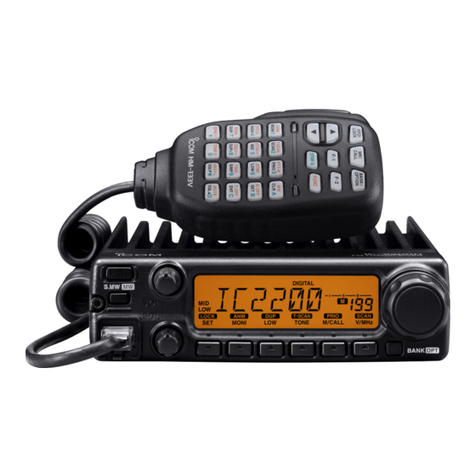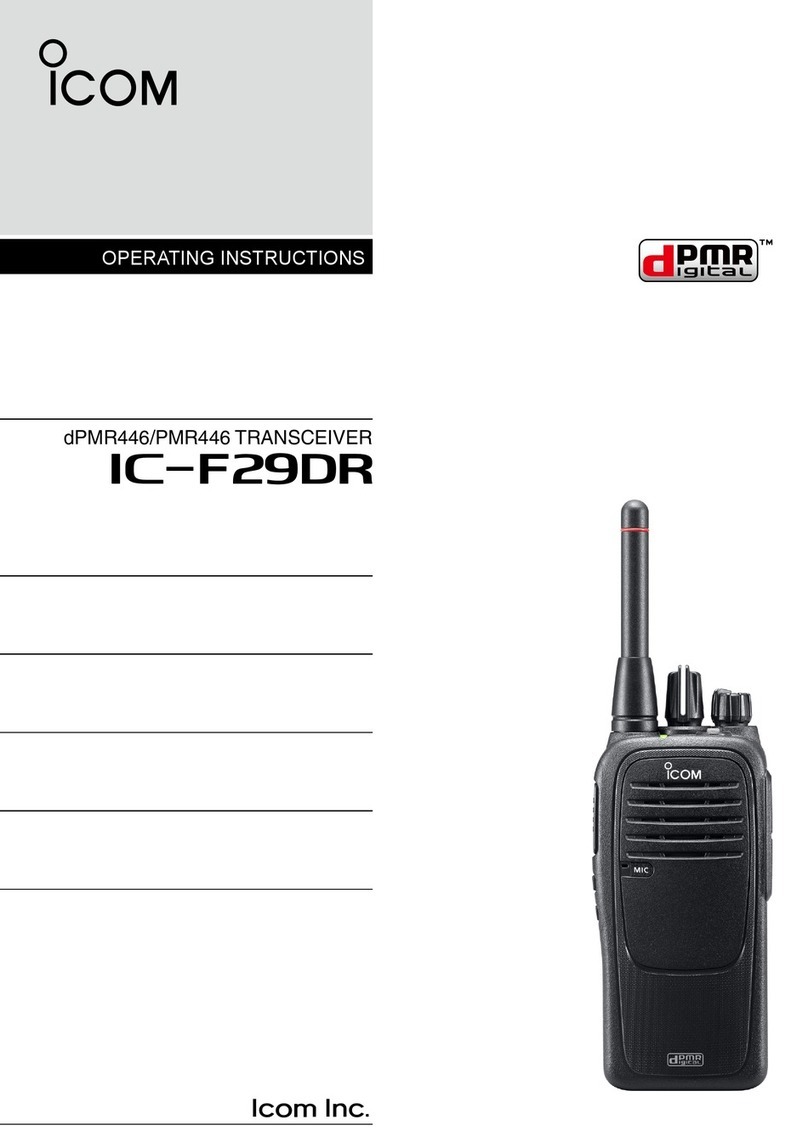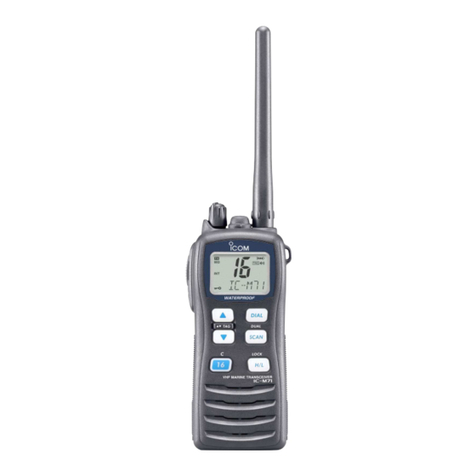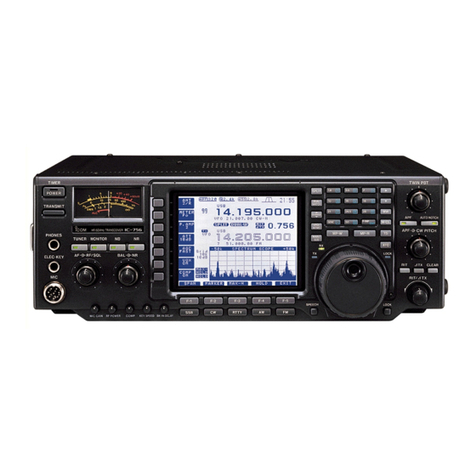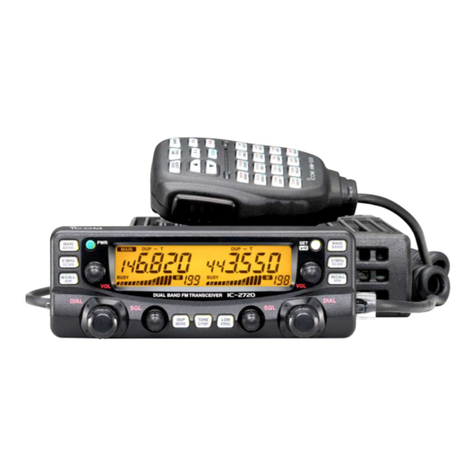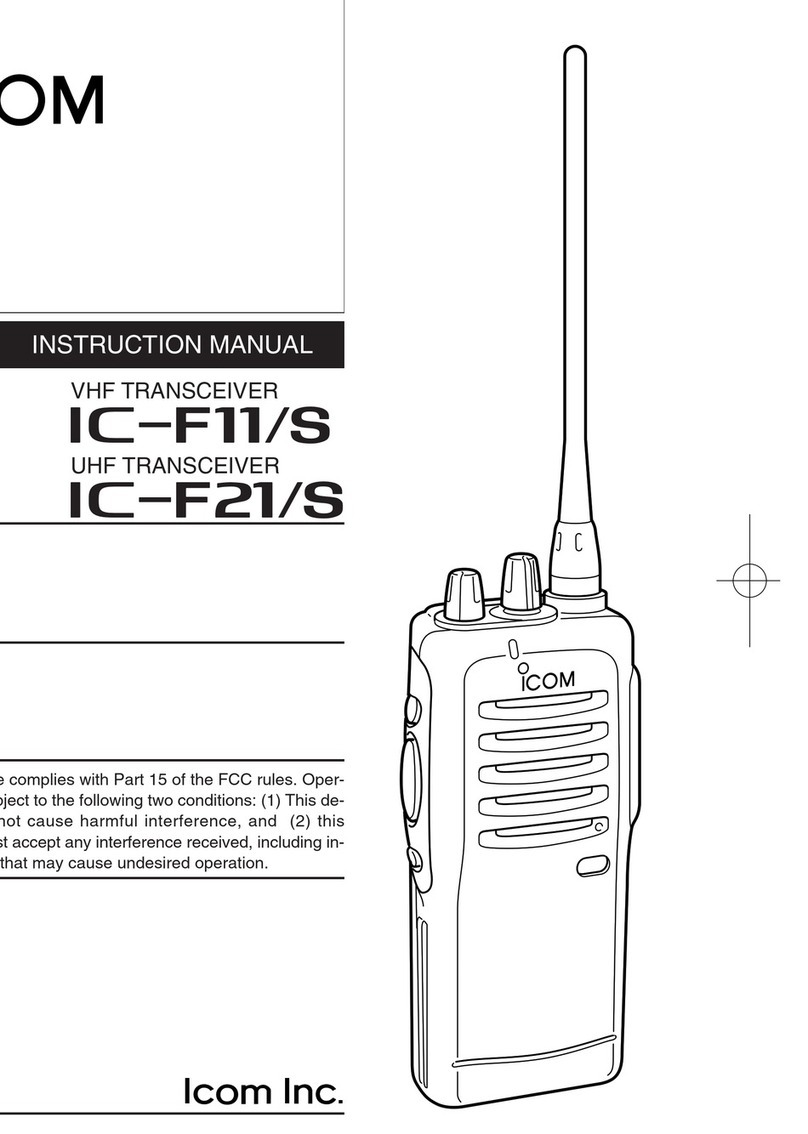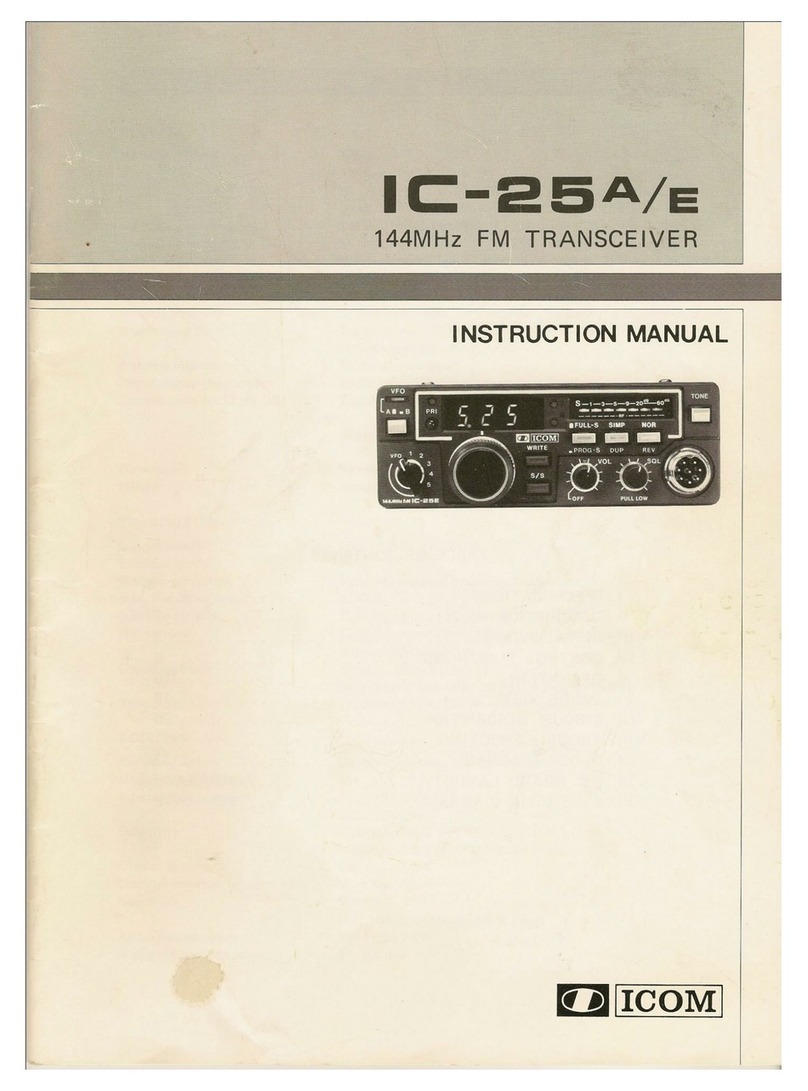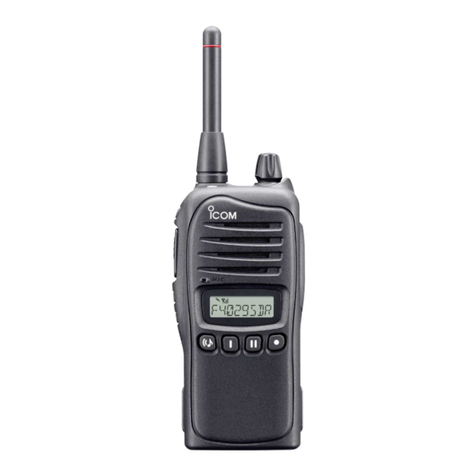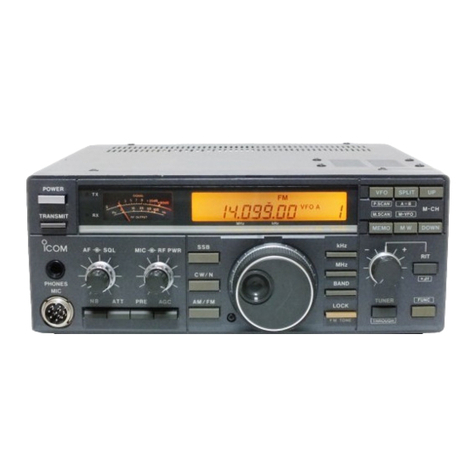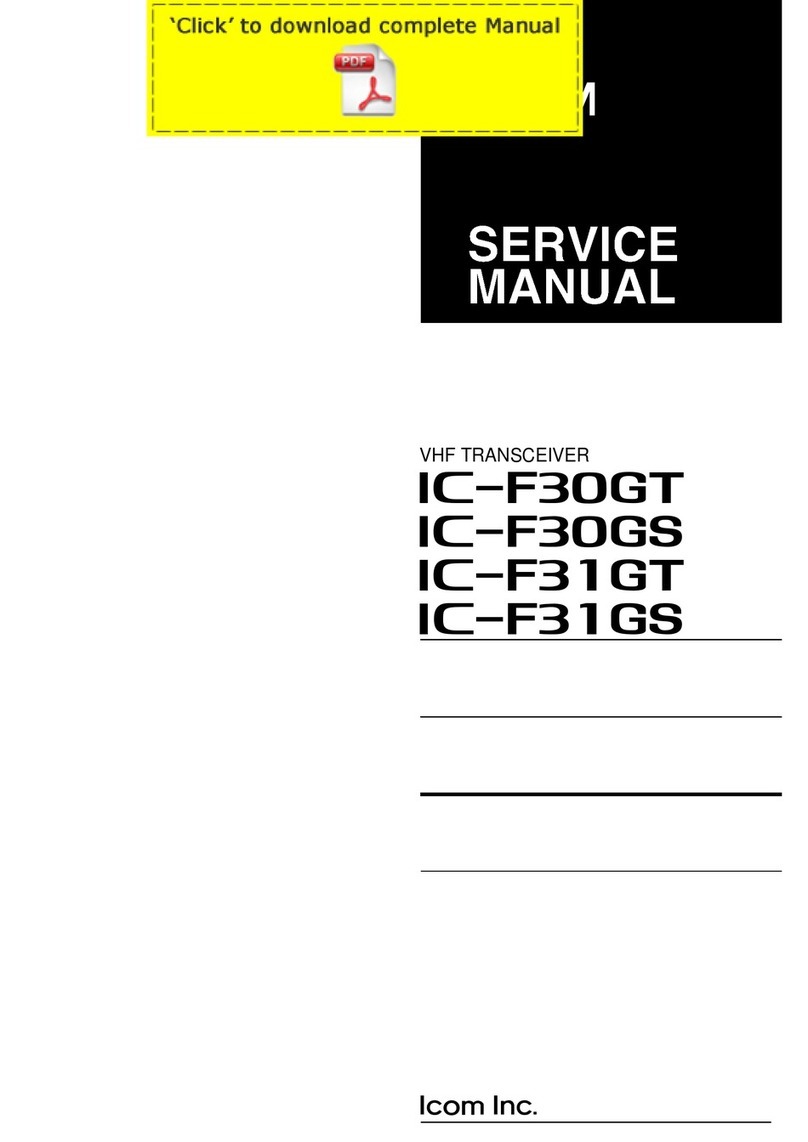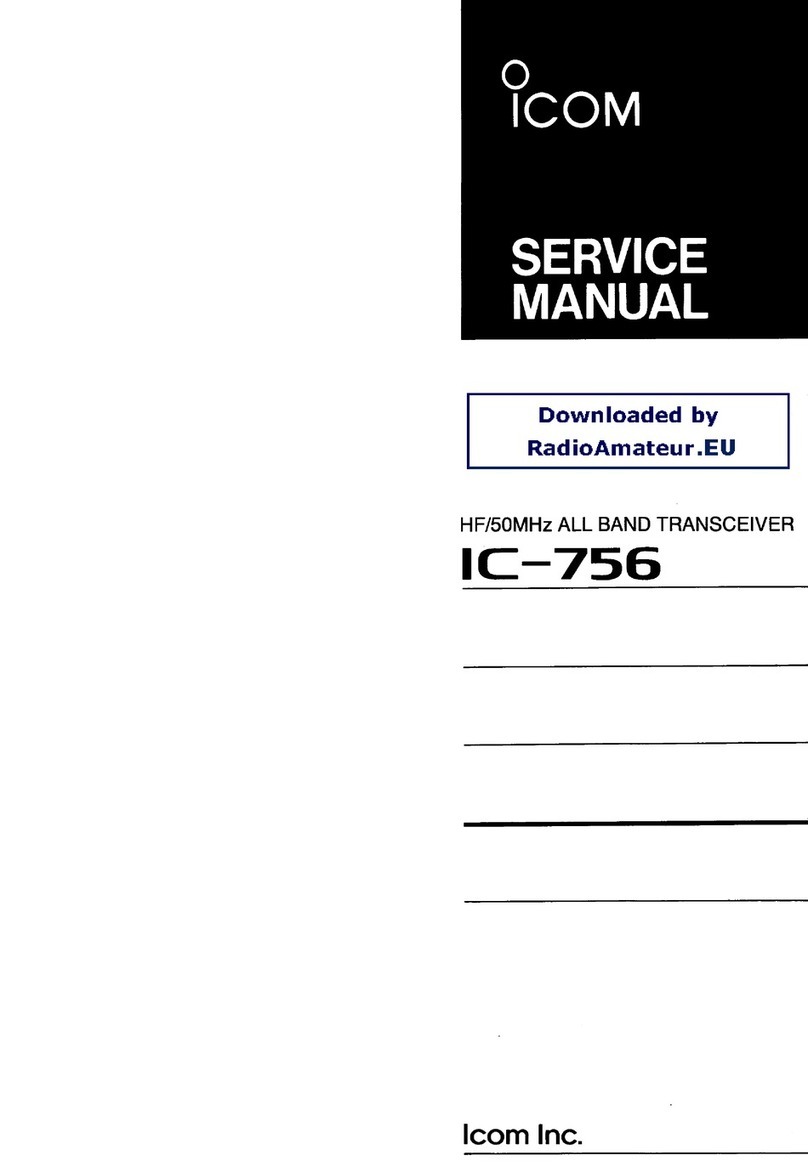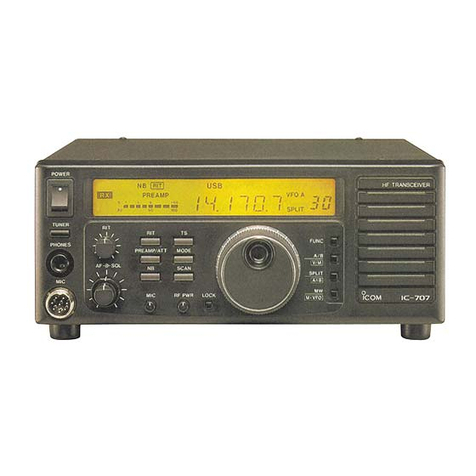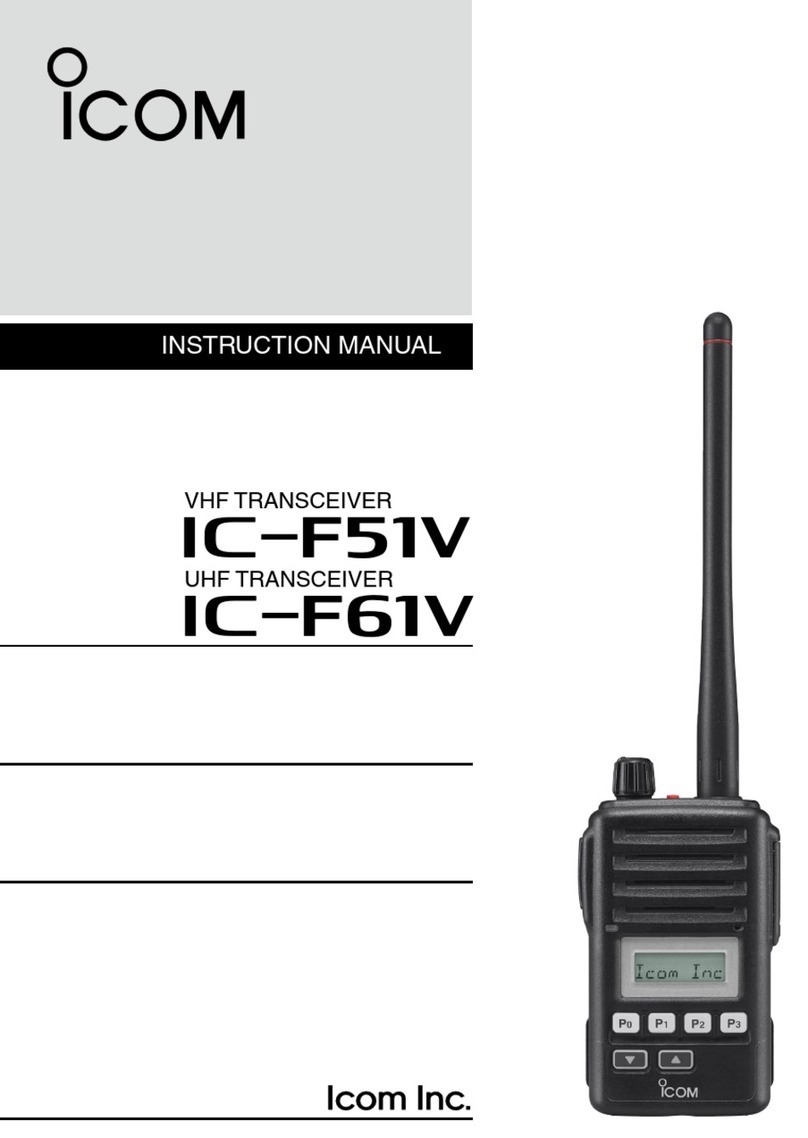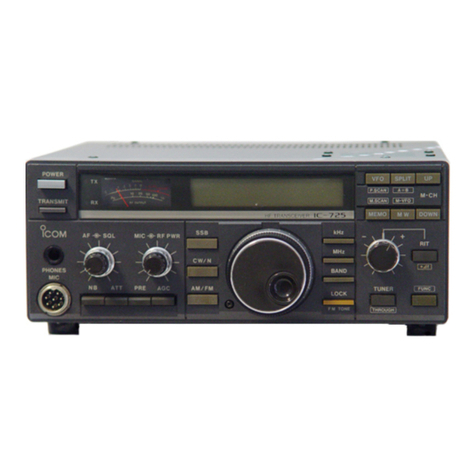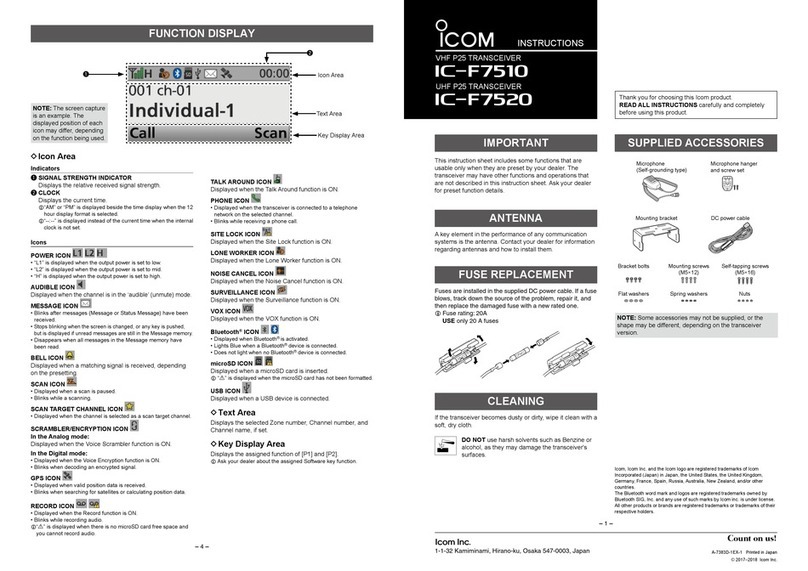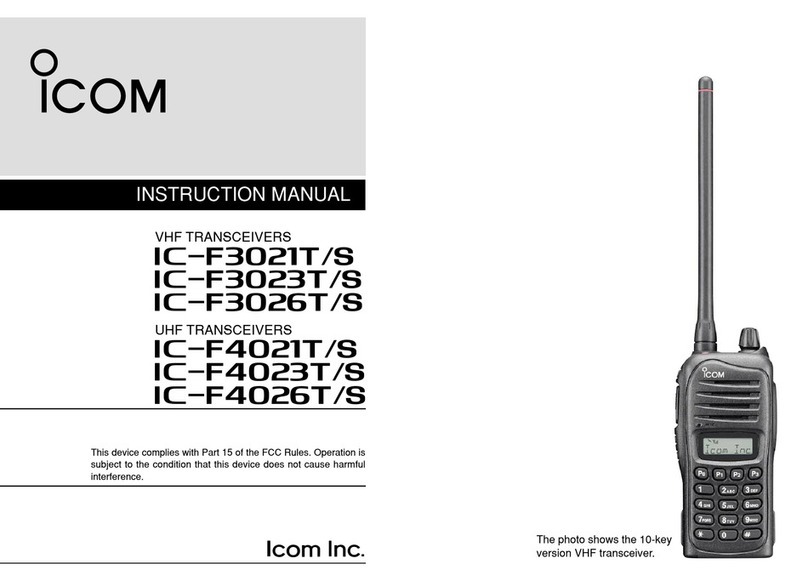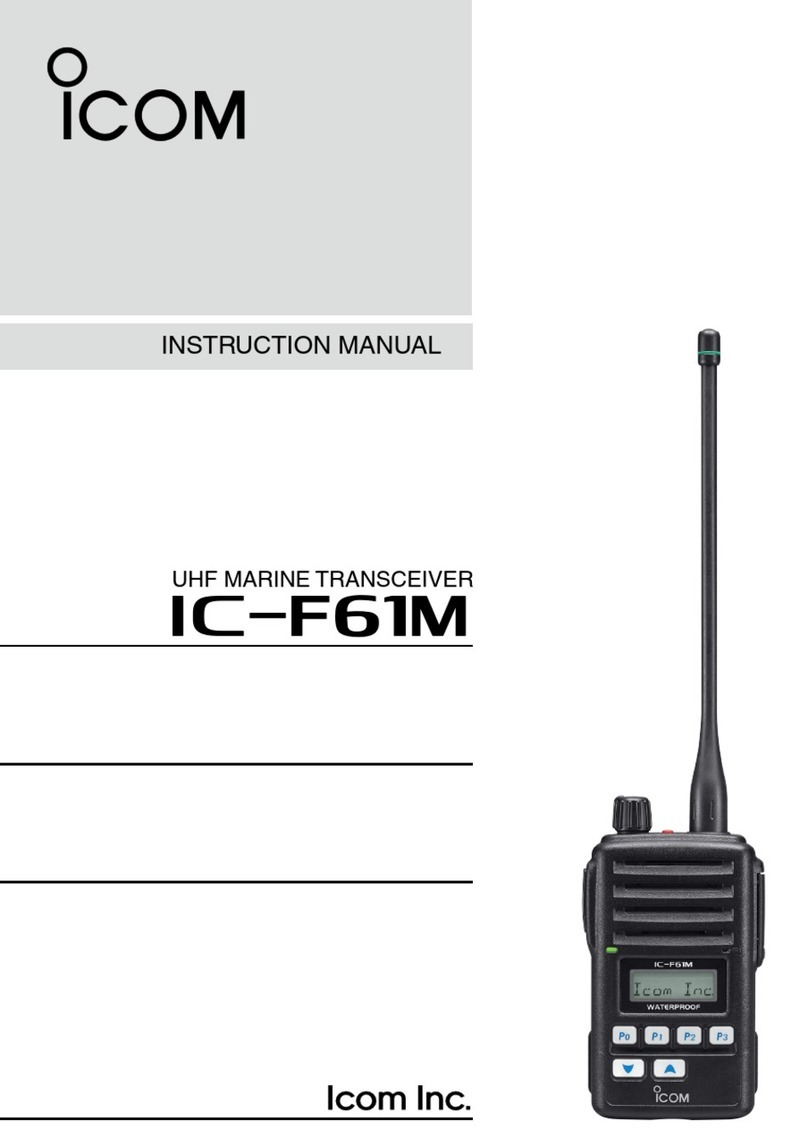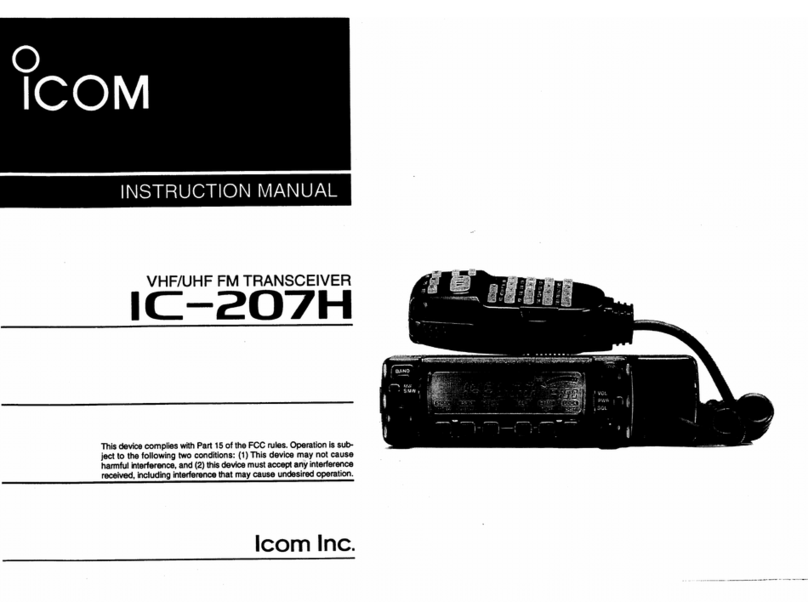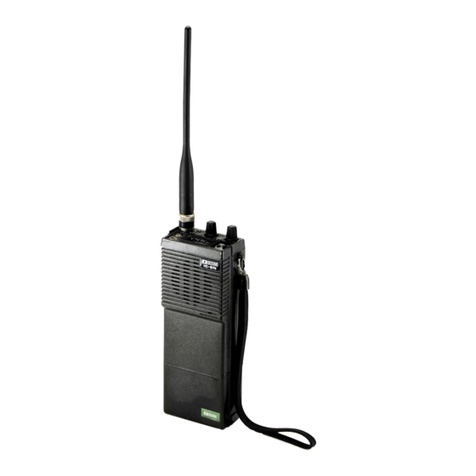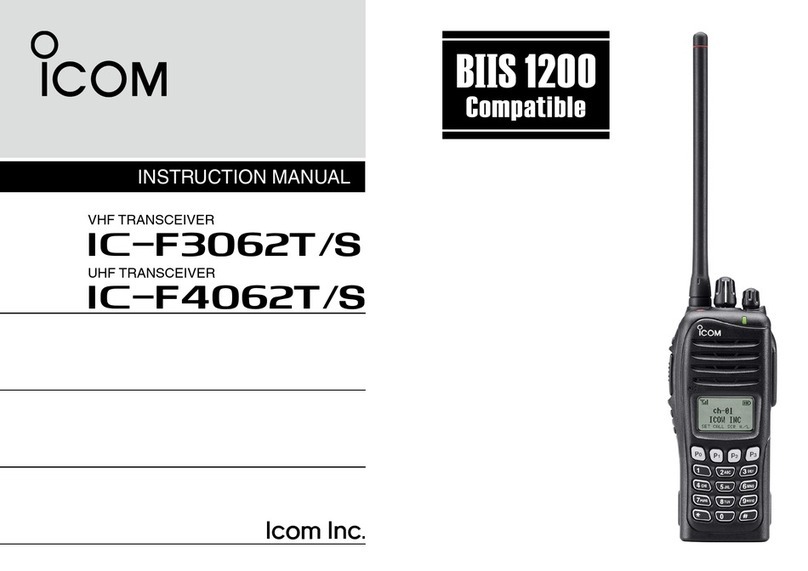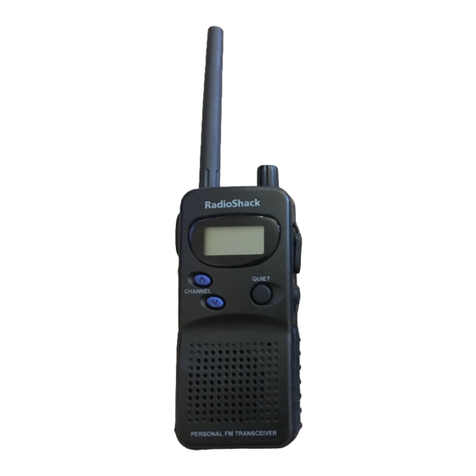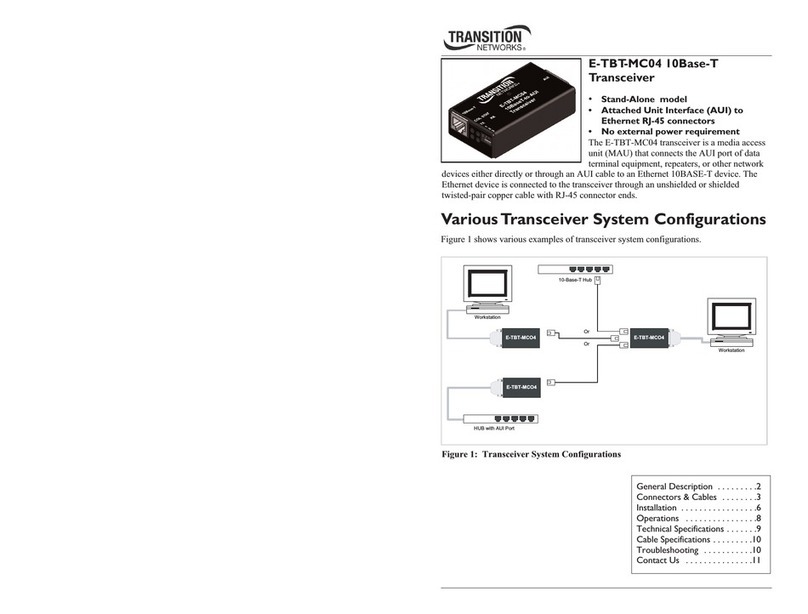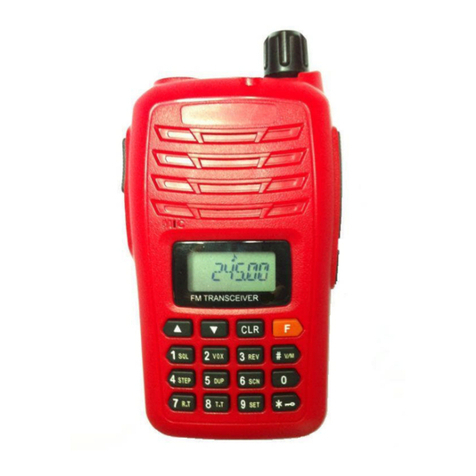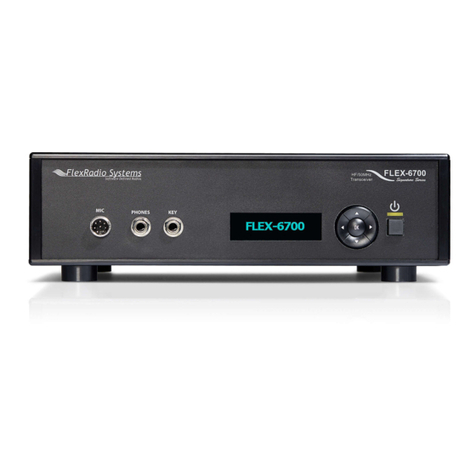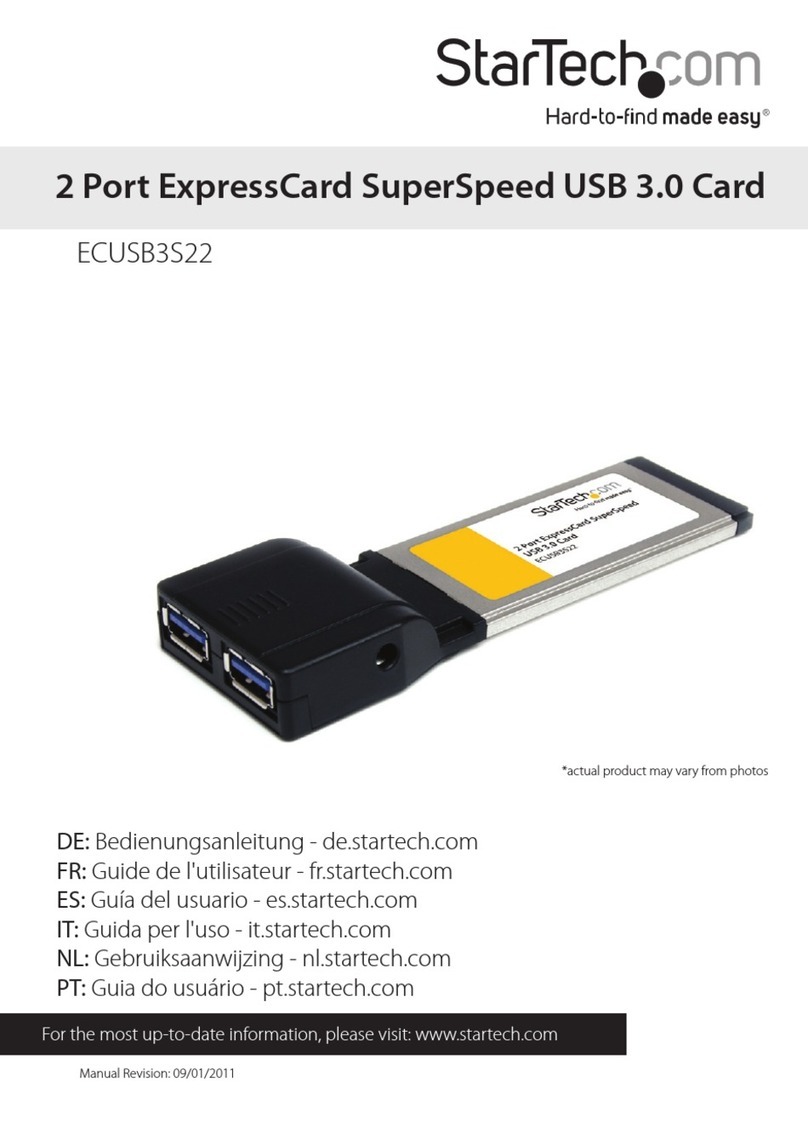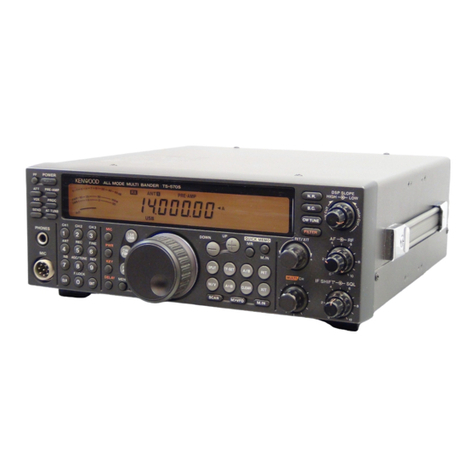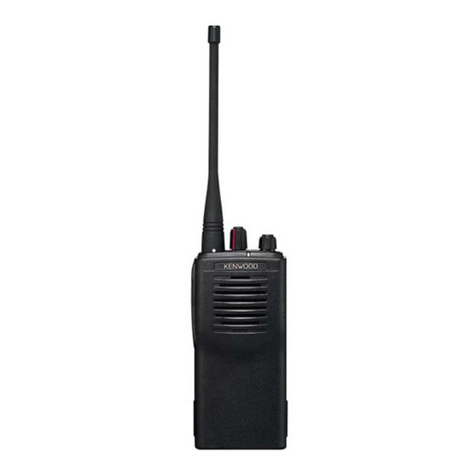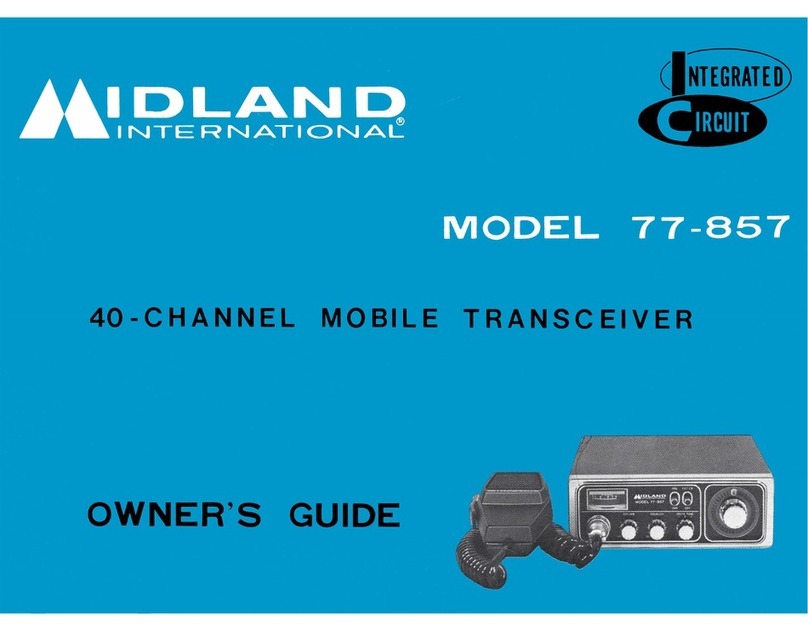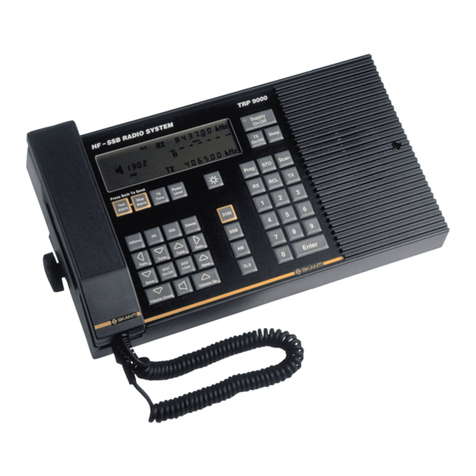Icom IC-F3021T/S User manual

INSTRUCTION MANUAL
This device complies with Part 15 of the FCC
Rules. Operation is subject to the condition that
this device does not cause harmful interference.
The photo shows the 10-key
version VHF transceiver.
iF3023T/S
iF3021T/S
VHF TRANSCEIVERS
iF3026T/S
iF4023T/S
iF4021T/S
UHF TRANSCEIVERS
iF4026T/S

i
RDANGER! NEVER short the terminals of the bat-
tery pack.
RWARNING! NEVER hold the transceiver so that
the antenna is very close to, or touching exposed parts of
the body, especially the face or eyes, while transmitting. The
transceiver will perform best if the microphone is 2 to 4 in. (5
to 10 cm) away from the lips and the transceiver is vertical.
RWARNING! NEVER operate the transceiver with a
headset or other audio accessories at high volume levels.
CAUTION! NEVER use non-Icom battery packs/ char-
gers to prevent the loss of the transceiver’s good performance
and warranty.
DO NOT push [PTT] when not actually desiring to trans-
mit.
DO NOT use or place the transceiver in direct sunlight or
in areas with temperatures below +22°F (–30°C) or above
+140°F (+60°C).
DO NOT modify the transceiver for any reason.
READ ALL INSTRUCTIONS carefully and com-
pletely before using the transceiver.
SAVE THIS INSTRUCTION MANUAL — This
instruction manual contains important operating instruc-
tions for the IC-F3021T/S, IC-F3023T/S, IC-F3026T/S VHF
TRANSCEIVERS and the IC-F4021T/S, IC-F4023T/S, IC-
F4026T/S UHF TRANSCEIVERS.
Icom, Icom Inc. and the Icom logo are registered trademarks of Icom Incor-
porated (Japan) in Japan, the United States, the United Kingdom, Germany,
France, Spain, Russia and/or other countries.
EXPLICIT DEFENITIONS
WORD DEFINITION
RDANGER Personal death, serious injury or an explo-
sion may occur.
RWARNING Personal injury, fire hazard or electric
shock may occur.
CAUTION Equipment damage may occur.
NOTE
If disregarded, inconvenience only. No risk
of personal injury, fire or electric shock.
IMPORTANT PRECAUTIONS

ii
KEEP the transceiver from the heavy rain, and Never im-
merse it in the water. The transceiver construction is water
resistant, not waterproof.
The basic operations, transmission and reception of the trans-
ceiver are guaranteed within the specified operating tempera-
ture range. However, the LCD display may not be operate
correctly, or show an indication in the case of long hours of
operation, or after being placed in extremely cold areas.
Approved Icom optional equipment is designed for optimal
performance when used with an Icom transceiver.
Icom is not responsible for the destruction or damage to an
Icom transceiver in the event the Icom transceiver is used with
equipment that is not manufactured or approved by Icom.
For U.S.A. only
CAUTION: Changes or modifications to this transceiver, not
expressly approved by Icom Inc., could void your authority to
operate this transceiver under FCC regulations.
FCC INFORMATION
• FOR CLASS B UNINTENTIONAL RADIATORS:
This equipment has been tested and found to comply with the
limits for a Class B digital device, pursuant to part 15 of the
FCC Rules. These limits are designed to provide reasonable
protection against harmful interference in a residential instal-
lation. This equipment generates, uses and can radiate radio
frequency energy and, if not installed and used in accordance
with the instructions, may cause harmful interference to radio
communications. However, there is no guarantee that inter-
ference will not occur in a particular installation. If this equip-
ment does cause harmful interference to radio or television
reception, which can be determined by turning the equipment
off and on, the user is encouraged to try to correct the inter-
ference by one or more of the following measures:
• Reorient or relocate the receiving antenna.
• Increase the separation between the equipment and re-
ceiver.
• Connect the equipment into an outlet on a circuit different
from that to which the receiver is connected.
• Consult the dealer or an experienced radio/TV technician
for help.
PRECAUTIONS

iii
TABLE OF CONTENTS
IMPORTANT.......................................................................... i
EXPLICIT DEFENITIONS ..................................................... i
PRECAUTIONS..................................................................... i
FCC INFORMATION ............................................................ ii
TABLE OF CONTENTS....................................................... iii
1 ACCESSORIES ...........................................................1–3
■Supplied accessories ...................................................1
■Accessory attachments ................................................1
2 PANEL DESCRIPTION................................................4–9
■Front panel ...................................................................4
■Function display ...........................................................6
■Programmable function keys ........................................7
3 BASIC OPERATION................................................10–16
■Turning power ON ......................................................10
■Channel selection.......................................................11
■Call procedure ............................................................11
■Receiving and transmitting .........................................12
■User set mode ............................................................14
■Priority A channel selection........................................14
■Emergency Call ..........................................................14
■Man Down Emergency Call........................................15
■Stun function ..............................................................15
■Scrambler function .....................................................15
■MDC 1200 system operation......................................16
4 BATTERY CHARGING ............................................17–21
■ Caution.......................................................................17
■Optional battery chargers...........................................19
5 BATTERY CASE............................................................22
■ Optional battery case (BP-240)..................................22
6 OPTIONAL SWIVEL BELT CLIP ............................23–24
■MB-93 contents ..........................................................23
■Attaching ....................................................................23
■Detaching ...................................................................24
7 OPTIONS.................................................................25–26
8 SAFETY TRAINING INFORMATION.............................27

1
1
ACCESSORIES
1
■Supplied accessories
NOTE: Some accessories are not supplied with depend-
ing on versions.
■Accessory attachments
DFlexible antenna
Connect the supplied flexible antenna
to the antenna connector.
CAUTION:
• NEVERHOLD the antenna when
carrying the transceiver.
• Transmitting without an antenna
may damage the transceiver.
Flexible antenna Battery pack Belt clip
Unit cover
(double-sided tape)*
Jack cover
(with screws)
*Use the unit cover as a spare. Ask your dealer for details.

2
1ACCESSORIES
DBattery pack
To attach the battery pack:
Slide the battery pack in the direction of the arrow (q), then
lock it with the battery release button.
• Slide the battery pack until the battery release button makes a
‘click’ sound.
To release the battery pack:
Slide the battery release button in the direction of the arrow
(w) as shown below. The battery pack is then released.
NEVER release or attach the battery pack when the
transceiver is wet or soiled. This may result water or dust
getting into the transceiver/battery pack and may result in
the transceiver being damaged.
DBelt clip
To attach the belt clip:
qRelease the battery pack if it is attached.
wSlide the belt clip in the direction of the arrow until the belt
clip is locked and makes a ‘click’ sound.
To detach the belt clip:
qRelease the battery pack if it is attached.
wPinch the clip (q), and slide the belt clip in the direction
of the arrow (w).
q
w
Battery release button
q
w

3
1
ACCESSORIES
1
DJack cover
Attach the jack cover when the optional speaker-microphone
or headset is not used.
To attach the jack cover:
qAttach the jack cover to the [MIC/SP] jack.
wTighten the screws.
CAUTION:
• Attach the jack cover when the optional speaker-micro-
phone or headset is not used.
• Use the supplied screws only.
To detach the jack cover:
qUnscrew the screws using a phillips screwdriver.
wDetach the jack cover for the speaker-microphone or
headset connection.
q
q
w
qw
[MIC/SP] jac
k
Jack cover

4
2PANEL DESCRIPTION
■Front panel
qANTENNA CONNECTOR
Connects the supplied antenna.
wDEALER-PROGRAMMABLE KEY [Emer]
Desired function can be programmed by your dealer.
(p. 7)
eDEALER-PROGRAMMABLE KEY [Side1]
Desired function can be programmed by your dealer.
(p. 7)
rPTT SWITCH [PTT]
Push and hold to transmit; release to receive.
tDEALER-PROGRAMMABLE KEYS [Side2]/[Side3]
Desired functions can be programmed independently by
your dealer. (p. 7)
y10-KEYPAD (Depending on version)
The keypad allows you to enter digits to:
• Select memory channels
• Select tone channels
• Select DTMF codes (during transmit)
• Set TX codes
• Start up with the password
uDEALER-PROGRAMMABLE KEYS [P0] to [P3]
Desired functions can be programmed independently by
your dealer. (p. 7)
iFUNCTION DISPLAY (p. 6)
Displays a variety of information such as an operating
channel number/name, 2-tone code, DTMF numbers, se-
lected function, etc.
q
w
r
eo
i
u
y
Microphone
Speaker
!0
t

5
2
PANEL DESCRIPTION
2
oEXTERNAL MICROPHONE/SPEAKER JACK
Connect an optional speaker-microphone or headset.
NOTE: Connect or disconnect the optional equipment
after the transceiver is turned OFF.
!0 VOLUME CONTROL [VOL]
Rotate to turn the power ON/OFF and adjusts the audio
level.
Jack cover
NOTE: Attach the jack
cover when the optional
equipment is not used.
See (p. 3) for details.

6
2PANEL DESCRIPTION
■Function display
yq iutrew
o
!0
qTRANSMIT INDICATOR
Appears while transmitting.
wBUSY INDICATOR
Appears while the channel is busy.
eSIGNAL STRENGTH INDICATOR
Indicates relative signal strength level.
rLOW POWER INDICATOR
Appears when low output power is selected.
• When the battery power decreases to a specified level, low
power is selected automatically.
tAUDIBLE INDICATOR
➥ Appears when the channel is in the ‘audible’ (unmute)
condition.
➥ Appears when the specified 2-tone code is received.
ySCRAMBLER INDICATOR
Appears when the voice scrambler function is activated.
uBELL INDICATOR
Appears/blinks when the specific 2-tone code is received,
according to the pre-programming.
iKEY LOCK INDICATOR
Appears during the key lock function is ON.
oBATTERY INDICATOR
Appears or blinks when the battery power decreases to a
specified level.
!0 ALPHANUMERIC DISPLAY
Displays an operating channel number, channel name,
Set mode contents, DTMF code, etc.

7
2
PANEL DESCRIPTION
2
■Programmable function keys
The following functions can be assigned to [Emer],[Side1],
[Side2], [Side3], [P0], [P1], [P2] and [P3] programmable
function keys.
Consult your Icom dealer or system operator for details con-
cerning your transceivers programming.
If the programmable function names are bracketed in the fol-
lowing explanations, the specific key is used to activate the
function depends on the programming.
CH UP AND DOWN KEYS
➥Push to select an operating channel.
➥Push to select a transmit code channel after pushing [TX
Code CH Select].
➥Push to select a DTMF channel after pushing [DTMF Au-
todial].
➥Push to select a scan group after pushing and holding
[Scan A Start/Stop]/[Scan B Start/Stop] for 1 sec.
ZONE KEY
Push this key, then push [CH Up] or [CH Down] to select the
desired zone.
What is “zone”?— The desired channels are assigned
into a zone according to the intended use for grouping.
For example, ‘Staff A’ and ‘Staff B’ are assigned into a
“Business” zone, and ‘John’ and ‘Cindy’ are assigned into
a “Private” zone.
SCAN A KEY
➥This key’s operation depends on the Power ON Scan set-
ting.
When the power ON scan function is turned OFF;
Push to start and cancel scanning operation. In case of
transmission during scan, scanning will be cancelled.
When the power ON scan function is turned ON;
Push to pause scanning, then resumes scanning after
passing a specified time period. In case of transmission
during scan, scanning will be cancelled.
➥Push and hold this key for 1 sec. to indicate the scan
group, then push [CH Up] or [CH Down] to select the de-
sired group.
SCAN B KEY
➥Push to start and cancel scanning operation. In case of
transmission during scan, scanning will be paused. Then
resumes scanning after passing a specified time period.
➥Push and hold this key for 1 sec. to indicate the scan
group, then push [CH Up] or [CH Down] to select the de-
sired group.
SCAN ADD/DEL (TAG) KEY
Push to add the channel to, or delete it from, the current
scanning list.

8
2PANEL DESCRIPTION
PRIO A/B KEYS
➥Push to select Priority A or Priority B channel.
➥Push and hold [Prio A (Rewrite)] or [Prio B (Rewrite)] for
1 sec. to reassign the operating channel to Priority A or
Priority B channel.
MR-CH 1/2/3/4 KEYS
Push to select memory channels 1 to 4 in the operating zone
directly.
MONI KEY
Mute and release the CTCSS (DTCS) or 2-tone squelch
mute. Open any squelch/deactivate any mute while pushing
and holding this key.
LOCK KEY
➥Push and hold for 1 sec. to electronically lock all program-
mable keys except the following:
[Call] (incl. Call A and Call B), [Moni], [Emergency],
[Surveillance], [Siren], [Lone Worker] and [OPT 1/2/3].
➥
Push and hold for 1 sec. again to turn the lock function OFF.
HIGH/LOW KEY
Push to select the transmit output power temporarily or per-
manently, depending on the pre-setting.
• Ask your dealer for the output power level for each selection.
C.TONE CH ENT KEY
Push to select the continuous tone channel using [CH Up]/
[CH Down] to change the tone frequency/code setting. The
selected channel remains set as the continuous tone chan-
nel until another channel is designated as such.
TALK AROUND KEY
Push to turn the talk around function ON and OFF.
• The talk around function equalizes the transmit frequency to the
receive frequency for transceiver-to-transceiver communication.
WIDE/NARROW KEY
Push to toggle the IF bandwidth between wide and narrow.
DTMF AUTODIAL KEY
➥Push to enter the DTMF channel selection mode. Then
select the desired DTMF channel using [CH Up]/[CH
Down].
➥After selecting the desired DTMF channel, push this key
to transmit the DTMF code.
RE-DIAL KEY
Push to transmit the last-transmitted DTMF code.
CALL KEYS
Push to transmit a 2-tone.
• Call transmission is necessary before you call another station
depending on your signaling system.
• [Call A] and/or [Call B] may be available when your system
employs selective ‘Individual/Group’ calls. Ask your dealer which
call is assigned to each key.
LONE WORKER KEY
Push to turn the Lone Worker function ON or OFF.
• If the Lone Worker function is activated, the Emergency function is
automatically turned ON after the specified time period has passed
with no operation is performed.

9
2
PANEL DESCRIPTION
2
EMERGENCY KEYS
Push and hold to transmit the emergency call.
• The transceiver can transmit the emergency call silently or audibly
depending on the pre-setting. Ask your dealer for details.
• When the emergency call transmits with beeps, the emergency
text is displayed on the LCD if programmed.
• If you want to cancel the emergency call, push and hold the key
again before transmitting the call.
• The emergency call is transmitted one time only or repeatedly until
receiving a control code, depending on the pre-setting.
SURVEILLANCE KEY
Push to turn the surveillance function ON or OFF.
When this function is turned ON, the beep is not emitted and
the LCD backlight does not light when a signal is received or
a key is pushed, etc.
SIREN KEY
Push to emit a siren.
TX CODE CHANNEL SELECT KEY
Push to enter the ID code channel selection mode directly.
Then set the desired channel using [CH Up]/[CH Down].
(p. 13)
TX CODE CHANNEL UP/DOWN KEYS
Push to select a TX code channel directly.
SCRAMBLER FUNCTION
Push to toggle the voice scrambler function ON and OFF.
USER SET MODE KEY
➥Push and hold for 1 sec. to enter user set mode.
• During in the user set mode, push this key to select an item that
is enabled by your dealer, and change the value or condition by
pushing [CH Up] or [CH Down].
➥Push and hold this key for 1 sec. again to exit user set
mode.
User set mode is also available via the ‘Power ON function.’
Refer to (p. 14) also.
OPT OUT KEYS
Push to control the output signal level of the optional ports in
the optional unit connector.
OPT MOMENTARY KEYS
Controls the output signal level of the optional ports in the
optional unit connector while pushing and holding this key.

■Turning power ON
Prior to using the transceiver for the first time, the battery
pack must be fully charged for optimum life and operation.
(p. 17)
qRotate [VOL] to turn the power ON.
wIf the transceiver is programmed for a start up password,
input the digit codes as directed by your dealer.
• 10-keypad can be used for password input depending on ver-
sion:
• The keys in the table below can be used for password input:
• The transceiver detects numbers in the same block as identical.
Therefore “01234” and “56789” are the same.
KEY
NUMBER 0
5
4
9
3
8
2
7
1
6
[Side3]
[P0]/[P1]/
[P2]/[P3]
Side3
[VOL]
eWhen the “PASSWORD” indication does not clear after
inputting 4 digits, the input code number may be incorrect.
Turn the power off and start over in this case.
DBattery type selection
The battery type must be selected according to the attaching
battery type when turning the transceiver ON.
Ask your dealer for details.
qTurn the power OFF.
wWhile pushing and holding [Emer] and [PTT], turn the
power ON with rotating [VOL] to toggle the attaching bat-
tery type.
• After the display appears, release [Emer] and [PTT].
• “DRY BATT” is displayed for about 3 sec. then “L” appears when
the battery case operation is selected. In this case, the transmit
output power is low.
• “LI-ION” is displayed for about 3 sec. when the Lithium-ion bat-
tery operation is selected.
[VOL]
[PTT]
[Emer]
Dry battery mode
Appears
10
3BASIC OPERATION

11
3
BASIC OPERATION
3
■Channel selection
Several types of channel selections are available. Methods
may differ according to your system set up.
NON-ZONE TYPE:
Push [CH Up] or [CH Down] to select the desired operating
channel, in sequence; or, push one of [MR-CH 1] to [MR-CH 4]
keys to select a channel directly.
ZONE TYPE:
Push [Zone], then push [CH Up] or [CH Down] to select the
desired zone.
AUTOMATIC SCAN TYPE:
Channel setting is not necessary for this type. When turning
power ON, the transceiver automatically starts scanning.
Scanning stops when receiving a call.
■Call procedure
When your system employs tone signaling (excluding CTCSS
and DTCS), the call procedure may be necessary prior to voice
transmission. The tone signaling employed may be a selective
calling system which allows you to call specific station(s) only
and prevent unwanted stations from contacting you.
qSelect the desired TX code channel or 2-tone code ac-
cording to your System Operator’s instructions.
• This may not be necessary depending on programming.
• Refer to page 13 for selection.
wPush [Call] (assigned to one of the dealer programmable
keys).
eAfter transmitting a 2-tone code, the remainder of your
communication can be carried out in the normal fashion.
Selective calling Non-selective calling

12
3BASIC OPERATION
■Receiving and transmitting
CAUTION: Transmitting without an antenna may damage
the transceiver. See page 1 for accessory attachments.
Receiving:
qRotate [VOL] to turn the power ON.
wPush [CH Up] or [CH Down] to select the conventional
system channel, in sequence.
eWhen receiving a call, adjust the audio output level to a
comfortable listening level.
NOTE: When a matched RX code signal is received, audio
from the microphone is automatically transmitted for a
specified time period.*
* Depending on the presetting. Ask your dealer for details.
Transmitting:
Wait for the channel to become clear to avoid interference.
qPush [Call] when initiating a call from your side.
•
Coded audio may be heard from the transceiver, then “ ” appears.
• This operation may not be necessary depending on your signal-
ing system. Ask your dealer for details.
wWhile pushing and holding [PTT], speak into the micro-
phone at a normal voice level.
eRelease [PTT] to return to receive.
IMPORTANT: To maximize the readability of your signal;
1. Pause briefly after pushing [PTT].
2. Hold the microphone 5 to 10 cm (2 to 4 inches) from
your mouth, then speak into the microphone at a normal
voice level.
DTransmitting notes
• Transmit inhibit function
The transceiver has several inhibit functions which restrict
transmission under the following conditions:
- The channel is in mute condition (‘Inaudible’ condition;
“ ” does not appear.)
- The channel is busy.
- Un-matched (or matched) CTCSS is received.
(Depending on the pre-setting.)
- The selected channel is a ‘receive only’ channel.
• Time-out timer
After continuous transmission for the pre-programmed time
period, the time-out timer is activated, causing the transceiver
to stop transmitting.
• Penalty timer
Once the time-out timer is activated, transmission is further
inhibited for a period determined by the penalty timer.
• PTTID call
The transceiver sends the ID code (DTMF or digital ANI) au-
tomatically when [PTT] is pushed (beginning of transmission)
and released (end of transmission) depends on the setting.

13
3
BASIC OPERATION
3
DTX code channel selection
If the transceiver has [TX Code CH Select] assigned to it,
the indication can be toggled between the operating channel
number (or name) and TX code channel number (or name).
When the TX code channel number (or name) is displayed,
[CH Up] or [CH Down] selects the TX code channel.
USING [TX CODE CH SELECT] KEY:
qPush [TX Code CH Select]— a TX code channel number
(or name) appears.
wPush [CH Up] or [CH Down] to select the desired TX code
channel.
• Push [TX Code CH Select] again to return to the operating chan-
nel number indication.
ePush [Call] to transmit the selected TX code.
USING [TX CODE CH UP]/[TX CODE CH DOWN] KEY:
If the transceiver has [TX Code CH Up] or [TX Code CH
Down] assignment, the programmed TX code channel can be
selected directly when pushed.
DDTMF transmission
If the transceiver has [DTMF Autodial] assigned to it, the
automatic DTMF transmission function is available. Up to 8
DTMF channels are available.
TO SELECT A TX CODE:
qPush [DTMF Autodial]— a DTMF channel appears.
wPush [CH Up] or [CH Down] to select the desired DTMF
channel.
ePush [DTMF Autodial] to transmit the DTMF code in the
selected DTMF channel.

14
3BASIC OPERATION
■User set mode
User set mode is accessed at power ON and allows you to
set seldom-changed settings. In this case you can “custom-
ize” the transceiver operation to suit your preferences and
operating style.
Entering the user set mode:
qWhile pushing and holding [Side2] and [Side3], rotate
[VOL] to turn the power ON.Then, push and hold [P0] for 1
sec. to enter user set mode.
wPush [P0] several times to select the appropriate item.
Then push [CH Up] or [CH Down] to set the desired level/
condition.
•
Available set mode functions are Backlight, Beep, Beep Level,
SQL Level, Mic Gain, Battery Voltage, Signal Moni and Lone
Worker.
eRotate [VOL] to turn the power OFF to exit user set mode.
NOTE: User set mode is also available via a programmable
function key. Refer to “USER SET MODE KEY.” (p. 9)
■Priority A channel selection
Depending on the presetting, the Priority A channel is selected
each time the transceiver power is turned ON.
■Emergency Call
When [Emergency] is pushed for the specified time period*,
the emergency signal is transmitted once, or repeatedly, on
the specified emergency channel.
A repeat emergency signal is automatically transmitted until
the transceiver receives an acknowledgement signal, or you
turn the transceiver power OFF.
When no emergency channel is specified, the signal is trans-
mitted on the previously selected channel.
If you want to cancel the emergency call, push and hold
[Emergency] again before transmitting the call.
If your transceiver is programmed for Silent operation, you
can transmit an Emergency call without the beep sounding
and the LED indicator lighting.
IMPORTANT: It is recommended to set an emergency
channel individually to provide the certain emergency call
operation.
* Depending on the presetting. Ask your dealer for details.

15
3
BASIC OPERATION
3
DNOTES
Depending on the presetting, the following functions are auto-
matically activated. Ask your dealer for details.
• Auto TX function
After the emergency call transmission, audio from the micro-
phone is automatically transmitted for a specified time period.*
• Auto RX function
After the emergency call transmission, the transceiver stands
by in the audible mode for the specified time period.*
■Man Down Emergency Call
This function requires the optional UT-124R man down unit.
When the transceiver has been left in a horizontal position for
the specified time period*, the transceiver enters the emer-
gency mode, and then the countdown starts.
After the specified time period* has passed, an emergency
call is automatically transmitted once, or repeatedly.
If the transceiver is placed in a vertical position before the first
transmission, the transceiver exits the emergency mode and
the emergency call is cancelled.
IMPORTANT: It is recommended to set an emergency
channel individually to provide the certain emergency call
operation.
* Depending on the presetting. Ask your dealer for details.
■Stun function
When the specified ID, set as a stun ID or kill ID, is received,
the stun function is activated.
When the stun ID is received, the transceiver becomes unus-
able. Entering of the password (p. 10) or receiving a specified
ID, set as a revive ID, is necessary to operate the transceiver
again in this case.
When the kill ID is received, the transceiver switches to the
cloning required condition. Cloning the transceiver is neces-
sary to operate the transceiver again in this case.
Stun function is also available with the MDC 1200 signaling
system. (p. 16)
■Scrambler function
The voice scrambler function provides private communication
between stations.The optional Rolling or Non-rolling type can
be available.
qPush [Scrambler] to turn the scrambler function ON.
• “ ” appears.
wPush [Scrambler] again to turn the scrambler function
OFF.
• “ ” disappears.

16
3BASIC OPERATION
■MDC 1200 system operation
The MDC 1200 signaling system enhances your transceiver’s
capabilities. It allows PTT ID*, Emergency signaling, and re-
ceiving Radio Check. Also, the dispatcher can stun and revive
transceivers on the system.
* When [PTT] is pushed and/or released, the transceiver transmits
your station ID.
DTransmitting an Emergency Call
The MDC 1200 system’s Emergency feature can be ac-
cessed using the [Emergency] key (p. 9). The transceiver will
send an Emergency MDC 1200 system command once, or
repeatedly for a programmed number of times until it receives
the acknowledgement signal.
The emergency call can be transmitted without a beep sound
depending on how the emergency function is programmed.
Ask your dealer for details.
DReceiving an Emergency Call
qWhen an emergency call is received;
• Beeps sound.
• The calling station alias and “EMG EMG” are displayed alter-
nately.
wTurn power OFF, change the channel, push [PTT] for reply-
ing the call, etc. to stop the beep and display indication.
DReceiving a Stun and Revive
The dispatcher can send MDC 1200 system signals that will
stun or revive your transceiver. If a Stun command is received
that matches your station ID, the transceiver will display
“SORRY” (default) and you can not receive or transmit. When
a Revive command is received that matches your station ID,
normal operation is restored.
Other manuals for IC-F3021T/S
1
This manual suits for next models
17
Table of contents
Other Icom Transceiver manuals

